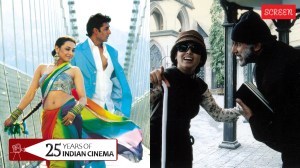Cover STORY
Forty years after the release of Pink Floyd’s first album, The Piper at the Gates of Dawn, we track down its India link—Lucknow-born photographer Vic Singh, who designed the cover n shamik bag

1967. che guevara was executed; Charlie Chaplin’s last film was released, the Summer of Love began in San Francisco, the Vietnam War raged, Jimi Hendrix let loose Are You Experienced?, the Beatles released Sgt. Pepper’s Lonely Hearts Club Band, Julia Roberts was born and Vivien Leigh died, the world was on the verge of a new high. And. Pink Floyd cut their first album, The Piper at the Gates of Dawn, and gave credence to the sound of psychedelia.
Exactly forty years since the band made its recording debut, the album has come to be recognised as a milestone of cultural history that prised open new horizons for music and mind.
As a strapping young photographer, surfing the swinging streets of London in 1967, India-born Vic Singh was in the thick of things when he first met the band members of Pink Floyd — guitarist-vocalist Syd Barrett, bassist Roger Waters, drummer Nick Mason and keyboardist Richard Wright—at an event in London’s Piccadilly. “At that time they were a new and comparatively unknown band. We chatted and they said they were making their first album,” he says.
The album cover of The Piper at the Gates of Dawn that the Lucknow-born photographer went on to create after getting a call from Floyd’s manager has since then assumed significance in multiple ways. After the critical success of their debut album — an unlikely proposition then, says Singh, “since it had a completely alien sound when the trend was set by Elvis, the Beatles and the Rolling Stones” — the band never featured their faces on the cover of their forthcoming albums.
The album, again, was the only one where the hallucinogenic genius of Syd Barrett was on display. And for many pop culture theorists, the album and its cover was the first real face of psychedelia.
Even though he wasn’t given a brief by the band, Singh knew what he wanted to do with the cover. As one of the five young photographers working at London’s Studio Five, which in a very short period of time had become the “hub” of what has now come to be known as The Swinging Sixties, Vic Singh contends that he was “ one of the original founders of the movement”. Not a stranger to the London youth culture as made memorable by Michelangelo Antonioni in Blow Up, Singh knew that the cover photograph of Piper needed far-out imagery. “Piper’s music was psychedelic, original, new and different from anything else at that time. The band had a small budget and wanted the cover in colour. There were no computers then and to do special effects in a conventional photo colour lab would cost an absolute fortune.”
The answer lay in a prism lens that George Harrison had given the photographer after the former Beatle could not find any use for it. Recounts Vic: “George and I were friends for many years. One afternoon at his house in Esher, where George, a film fanatic, had built a cinema in the sitting room, he produced the prism lens and said ‘I don’t know what to use it for. You might find a use for it as you’re a photographer.’ I could not find a use for it either until The Pink Floyd album.”
It was Barrett who took charge of getting the band ready for the shoot, using the brightly coloured clothes that Singh had asked for and checking the test Polaroid colour films. One of the founders of the band, who passed away recently, Barrett also designed the back cover. “The photo session was laidback and lasted the day. The morning was spent chatting, listening to sounds, drinking coffee and getting high. After lunch, we started the shoot. As the photography progressed, we all started to get more engrossed in the images. Syd helping me to position the group correctly so that the overlapping images of each band member created by the prism lens looked right. The members were in a happy frame of mind, especially when they saw the results on the Polaroid film. Syd picked the one image from the session into which he could neatly drop in the lettering and still see all the band members. We enjoyed the shoot, having created a psychedelic visual that went with the music,” says the 67-year-old London-based photographer, whose father was the scion of a North Indian royal family.
“My love for bright colours and the mysterious mystical realms expressed in my images probably are inspired from my Indian background. Yet, it is a pity that my work does not have closer ties with India. I have not had a chance to work in India or with Indian subjects,” he adds.
After having come to London to study at St Christopher’s College before taking up photography, Singh had to struggle his way up the professional ladder after having worked as an assistant in Mayflower Studios—his duties including delivering prints, making tea and sweeping the studio floor for £3 a week.
Today, his website, vicsingh.co.uk, is a mine of popular culture memorabilia with references to his work with The Beatles, “who asked me to shoot a film of A Day In The Life when they were finishing the recording of Sgt. Pepper’s Lonely Hearts Club Band at the Abbey Road Studios”, Jimmy Cliff and The Spencer Davis Group.
The Piper at the Gates of Dawn, understandably, is also his favourite Floyd album.



- 01
- 02
- 03
- 04
- 05




























